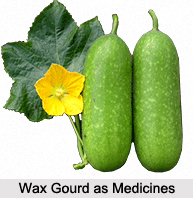 Wax Gourd or Benincasa cerifera is eaten by the natives in their curries and is extensively cultivated all over India. It is considered tonic, nutritive and diuretic and a specific for haemoptysis and other hemorrhages from internal organs. The "Raja Nighantu", the oldest work on therapeutics, gives a long account of its virtues. The more recent compilations, such as "Chakradatta Sangraha", "Sarangadhara" etc. gives numerous preparations of the gourd and details its uses.
Wax Gourd or Benincasa cerifera is eaten by the natives in their curries and is extensively cultivated all over India. It is considered tonic, nutritive and diuretic and a specific for haemoptysis and other hemorrhages from internal organs. The "Raja Nighantu", the oldest work on therapeutics, gives a long account of its virtues. The more recent compilations, such as "Chakradatta Sangraha", "Sarangadhara" etc. gives numerous preparations of the gourd and details its uses.
Dose of Wax Gourd in Medicine
"Khanda Kushmandaka" is useful in haemoptysis, phthisis, marasmus, cough, asthma, ulceration of the lungs, hoarseness, etc. In preparing this medicine, old ripe gourds which are at least a year old are selected. They are longitudinally divided into 2 halves and the pulp scraped out in thin flakes. The watery juice that oozes out abundantly during this process is preserved, the seeds being rejected. The pulp is boiled in the above mentioned juice, till softened. It is then tied up tightly in a cloth and the fluid portion allowed to strain through it. The softened and drained pulp is dried in the sun and the watery portion preserved for future use. 50 tolas of the prepared pulp are fried in 16 tolas of clarified butter and again boiled in the juice of the fruit, till reduced to the consistence of honey. To this are added 50 tolas of refined sugar and the whole is heated over a gentle fire, till the mass assumes such a consistence as to adhere to the ladle. The pot is now removed from the fire and the following substances, namely, long pepper and ginger each 2 tolas, cumin seeds, cardamoms, cinnamon, leaves called tejapatra, black pepper and coriander each half a tola in fine powder are added to the syrup and stirred briskly with a ladle till the mass is cool. 8 tolas of honey are now added to the confection which is preserved in a new earthen pot. The dose of this medicine is from 1 to 2 tolas, according to the age and strength of the patient.
"Vasa Kushmanda Khanda" is a preparation used in cough, asthma, phthisis, haemoptysis, heart diseases and catarrh. Take the root of Justicia Adhatoda (vasaka) 1 seer, water 8 seers; boil together till reduced to one-fourth and strain. Then take of the pulp of Benincasa cerifera, prepared as above described 50 tolas; fry it in 32 tolas of clarified butter and boil in the decoction of vasaka till the whole is reduced to the consistence of honey. Add to it sugar 100 tolas and apply heat till the mass thickens to the proper consistence. Remove from the fire, add the following substances in fine powder, namely, tubers of Cyperus rotundus (mustaka), dried emblic myrobalan, bamboo manna, root of Clerodendron Siphonanthus (brahmayasti), a fragrant substance called elabaluka, cinnamon, cardamom, tejapatra each quarter of a tola, ginger, coriander and black pepper each 1 tola, long pepper 4 tolas, stir well till the confection cools and lastly add 8 tolas of honey.
In insanity, epilepsy and other nervous diseases, the fresh juice of the squash is given either with sugar or as an adjunct to other medicines for these diseases.
A ghrita for use in these diseases is also prepared as follows. Kushmandaka Ghrita: Take the juice of Benincasa cerifera 18 seers, clarified butter 1 seer, liquorice root beaten into a paste with water, quarter of a seer. Boil them together and prepare a ghrita in the usual way. Dose should be 1 to 2 tolas.
Related Articles
Ayurveda
Ayurveda Medication
Elements of Ayurveda
Concepts of Ayurveda
Ancient Literature of Ayurveda
Sushruta Samhita
Classification of Medicine





